HI5017 Managerial Accounting: Activity Based Costing & EWC Analysis
VerifiedAdded on 2023/06/12
|10
|2716
|356
Report
AI Summary
This report provides a detailed analysis of Activity Based Costing (ABC) as a management accounting tool, focusing on its model, features, and benefits for cost reduction and profitability enhancement. It evaluates the potential implementation of ABC by Energy World Corporation Ltd (EWC), recommending its use to optimize operational costs. Furthermore, the report suggests incorporating performance measurement as another valuable management accounting tool for EWC, emphasizing the importance of financial and non-financial data in assessing and improving overall performance. The analysis covers ABC's alignment with EWC's goals, strategic pillars, and objectives, highlighting the role of cost centers and activity analysis in achieving targets. The report concludes with recommendations for breaking down activities, assigning cost pools, and leveraging performance measurement to drive efficiency and growth.

qwertyuiopasdfghjklzxcvbnmqwertyui
opasdfghjklzxcvbnmqwertyuiopasdfgh
jklzxcvbnmqwertyuiopasdfghjklzxcvb
nmqwertyuiopasdfghjklzxcvbnmqwer
tyuiopasdfghjklzxcvbnmqwertyuiopas
dfghjklzxcvbnmqwertyuiopasdfghjklzx
cvbnmqwertyuiopasdfghjklzxcvbnmq
wertyuiopasdfghjklzxcvbnmqwertyuio
pasdfghjklzxcvbnmqwertyuiopasdfghj
klzxcvbnmqwertyuiopasdfghjklzxcvbn
mqwertyuiopasdfghjklzxcvbnmqwerty
uiopasdfghjklzxcvbnmqwertyuiopasdf
ghjklzxcvbnmqwertyuiopasdfghjklzxc
vbnmqwertyuiopasdfghjklzxcvbnmrty
uiopasdfghjklzxcvbnmqwertyuiopasdf
ghjklzxcvbnmqwertyuiopasdfghjklzxc
vbnmqwertyuiopasdfghjklzxcvbnmqw
Managerial Accounting
opasdfghjklzxcvbnmqwertyuiopasdfgh
jklzxcvbnmqwertyuiopasdfghjklzxcvb
nmqwertyuiopasdfghjklzxcvbnmqwer
tyuiopasdfghjklzxcvbnmqwertyuiopas
dfghjklzxcvbnmqwertyuiopasdfghjklzx
cvbnmqwertyuiopasdfghjklzxcvbnmq
wertyuiopasdfghjklzxcvbnmqwertyuio
pasdfghjklzxcvbnmqwertyuiopasdfghj
klzxcvbnmqwertyuiopasdfghjklzxcvbn
mqwertyuiopasdfghjklzxcvbnmqwerty
uiopasdfghjklzxcvbnmqwertyuiopasdf
ghjklzxcvbnmqwertyuiopasdfghjklzxc
vbnmqwertyuiopasdfghjklzxcvbnmrty
uiopasdfghjklzxcvbnmqwertyuiopasdf
ghjklzxcvbnmqwertyuiopasdfghjklzxc
vbnmqwertyuiopasdfghjklzxcvbnmqw
Managerial Accounting
Paraphrase This Document
Need a fresh take? Get an instant paraphrase of this document with our AI Paraphraser

Executive Summary
The report focuses on the explanation and advantages of using Activity Based Costing as
a management accounting tool. It also suggests how a company can make full utilization
of the ABC system of costing to minimize its operative costs and enhance its
profitability as a whole.
In the initial part of the report, the model and features of the ABC system of costing have
been explained. Afterward the signs of implementation of Activity Based Costing by the
company Energy World Corporation Ltd (an Australian Company) have been evaluated.
Also, the recommendation for its use has been given as applicable to the company. In the
latter part of the report, another management accounting tool has been recommended to
the company namely Performance Measurement.
2
The report focuses on the explanation and advantages of using Activity Based Costing as
a management accounting tool. It also suggests how a company can make full utilization
of the ABC system of costing to minimize its operative costs and enhance its
profitability as a whole.
In the initial part of the report, the model and features of the ABC system of costing have
been explained. Afterward the signs of implementation of Activity Based Costing by the
company Energy World Corporation Ltd (an Australian Company) have been evaluated.
Also, the recommendation for its use has been given as applicable to the company. In the
latter part of the report, another management accounting tool has been recommended to
the company namely Performance Measurement.
2
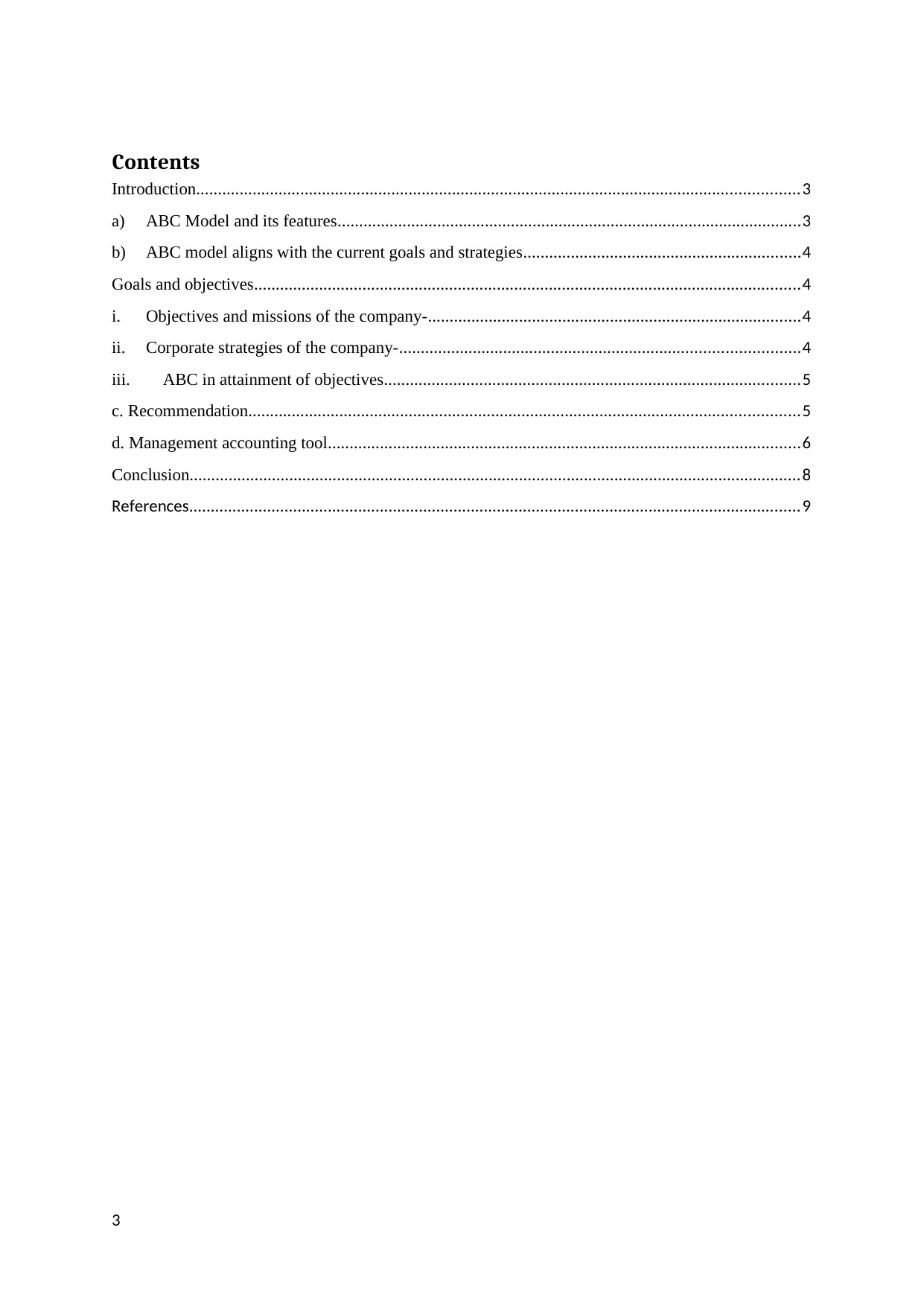
Contents
Introduction...........................................................................................................................................3
a) ABC Model and its features...........................................................................................................3
b) ABC model aligns with the current goals and strategies................................................................4
Goals and objectives..............................................................................................................................4
i. Objectives and missions of the company-......................................................................................4
ii. Corporate strategies of the company-............................................................................................4
iii. ABC in attainment of objectives................................................................................................5
c. Recommendation...............................................................................................................................5
d. Management accounting tool.............................................................................................................6
Conclusion.............................................................................................................................................8
References.............................................................................................................................................9
3
Introduction...........................................................................................................................................3
a) ABC Model and its features...........................................................................................................3
b) ABC model aligns with the current goals and strategies................................................................4
Goals and objectives..............................................................................................................................4
i. Objectives and missions of the company-......................................................................................4
ii. Corporate strategies of the company-............................................................................................4
iii. ABC in attainment of objectives................................................................................................5
c. Recommendation...............................................................................................................................5
d. Management accounting tool.............................................................................................................6
Conclusion.............................................................................................................................................8
References.............................................................................................................................................9
3
⊘ This is a preview!⊘
Do you want full access?
Subscribe today to unlock all pages.

Trusted by 1+ million students worldwide
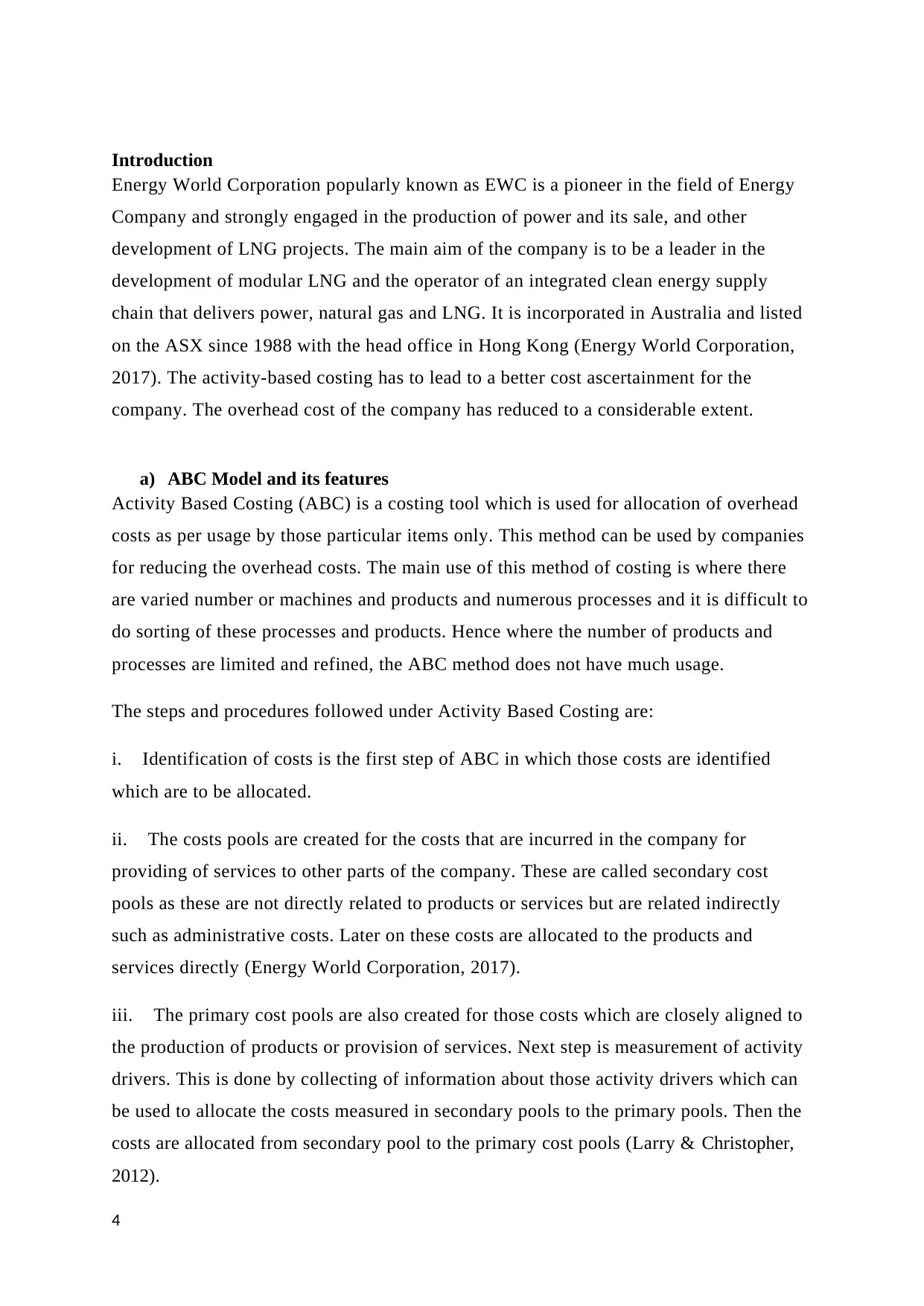
Introduction
Energy World Corporation popularly known as EWC is a pioneer in the field of Energy
Company and strongly engaged in the production of power and its sale, and other
development of LNG projects. The main aim of the company is to be a leader in the
development of modular LNG and the operator of an integrated clean energy supply
chain that delivers power, natural gas and LNG. It is incorporated in Australia and listed
on the ASX since 1988 with the head office in Hong Kong (Energy World Corporation,
2017). The activity-based costing has to lead to a better cost ascertainment for the
company. The overhead cost of the company has reduced to a considerable extent.
a) ABC Model and its features
Activity Based Costing (ABC) is a costing tool which is used for allocation of overhead
costs as per usage by those particular items only. This method can be used by companies
for reducing the overhead costs. The main use of this method of costing is where there
are varied number or machines and products and numerous processes and it is difficult to
do sorting of these processes and products. Hence where the number of products and
processes are limited and refined, the ABC method does not have much usage.
The steps and procedures followed under Activity Based Costing are:
i. Identification of costs is the first step of ABC in which those costs are identified
which are to be allocated.
ii. The costs pools are created for the costs that are incurred in the company for
providing of services to other parts of the company. These are called secondary cost
pools as these are not directly related to products or services but are related indirectly
such as administrative costs. Later on these costs are allocated to the products and
services directly (Energy World Corporation, 2017).
iii. The primary cost pools are also created for those costs which are closely aligned to
the production of products or provision of services. Next step is measurement of activity
drivers. This is done by collecting of information about those activity drivers which can
be used to allocate the costs measured in secondary pools to the primary pools. Then the
costs are allocated from secondary pool to the primary cost pools (Larry & Christopher,
2012).
4
Energy World Corporation popularly known as EWC is a pioneer in the field of Energy
Company and strongly engaged in the production of power and its sale, and other
development of LNG projects. The main aim of the company is to be a leader in the
development of modular LNG and the operator of an integrated clean energy supply
chain that delivers power, natural gas and LNG. It is incorporated in Australia and listed
on the ASX since 1988 with the head office in Hong Kong (Energy World Corporation,
2017). The activity-based costing has to lead to a better cost ascertainment for the
company. The overhead cost of the company has reduced to a considerable extent.
a) ABC Model and its features
Activity Based Costing (ABC) is a costing tool which is used for allocation of overhead
costs as per usage by those particular items only. This method can be used by companies
for reducing the overhead costs. The main use of this method of costing is where there
are varied number or machines and products and numerous processes and it is difficult to
do sorting of these processes and products. Hence where the number of products and
processes are limited and refined, the ABC method does not have much usage.
The steps and procedures followed under Activity Based Costing are:
i. Identification of costs is the first step of ABC in which those costs are identified
which are to be allocated.
ii. The costs pools are created for the costs that are incurred in the company for
providing of services to other parts of the company. These are called secondary cost
pools as these are not directly related to products or services but are related indirectly
such as administrative costs. Later on these costs are allocated to the products and
services directly (Energy World Corporation, 2017).
iii. The primary cost pools are also created for those costs which are closely aligned to
the production of products or provision of services. Next step is measurement of activity
drivers. This is done by collecting of information about those activity drivers which can
be used to allocate the costs measured in secondary pools to the primary pools. Then the
costs are allocated from secondary pool to the primary cost pools (Larry & Christopher,
2012).
4
Paraphrase This Document
Need a fresh take? Get an instant paraphrase of this document with our AI Paraphraser

iv. Using the activity drivers, the primary cost pools are allocated to the cost objects.
For this purpose, the total cost in a pool is to be divided by total number of activities in
the activity driver. This results in cost per activity unit and is further allocated to the cost
objects (Energy World Corporation, 2017). The results of ABC are then formulated into
reports to be used by the management and the requisite actions are taken to minimise the
costs of the products or cost objects.
b) ABC model aligns with the current goals and strategies
The ABC method of costing in Energy World Corporation Ltd divided the total cost of
the product into fixed costs and variable costs. This division is important as it helps the
entity to provide quality information so that a proper system of costing can be designed
and implemented. Under this system of costing, the adequate distinction is made for the
patterns of different cost behaviours (Energy World Corporation, 2017). Further, there
are different patterns related to costs in an entity which includes volumes, diversity,
events, time, usage, etc. There is a proper appropriation of the cost drivers towards the
tracing of overhead to the different classes of products. The behavior pattern of the costs
is decided by the cost drivers allocated to them (Marsh, 2009).
Goals and objectives
i. Objectives and missions of the company-
The objectives and missions of the company Energy World Corporation Ltd are to be the
best oil and gas company in Australia and all over the world. Also, the main purpose of
the company is to deliver a substantial and sustainable growth to the shareholder's value
(Energy World Corporation, 2017). The company aims to achieve maximum reduction in
its operating costs and increasing the shareholders’ worth by increasing the profitability
of the company.
ii. Corporate strategies of the company-
In order to achieve the objectives, the company has designed its strategies in the form of
strategic pillars which shall help the company in all the decision making of the company.
The strategic pillars are:
5
For this purpose, the total cost in a pool is to be divided by total number of activities in
the activity driver. This results in cost per activity unit and is further allocated to the cost
objects (Energy World Corporation, 2017). The results of ABC are then formulated into
reports to be used by the management and the requisite actions are taken to minimise the
costs of the products or cost objects.
b) ABC model aligns with the current goals and strategies
The ABC method of costing in Energy World Corporation Ltd divided the total cost of
the product into fixed costs and variable costs. This division is important as it helps the
entity to provide quality information so that a proper system of costing can be designed
and implemented. Under this system of costing, the adequate distinction is made for the
patterns of different cost behaviours (Energy World Corporation, 2017). Further, there
are different patterns related to costs in an entity which includes volumes, diversity,
events, time, usage, etc. There is a proper appropriation of the cost drivers towards the
tracing of overhead to the different classes of products. The behavior pattern of the costs
is decided by the cost drivers allocated to them (Marsh, 2009).
Goals and objectives
i. Objectives and missions of the company-
The objectives and missions of the company Energy World Corporation Ltd are to be the
best oil and gas company in Australia and all over the world. Also, the main purpose of
the company is to deliver a substantial and sustainable growth to the shareholder's value
(Energy World Corporation, 2017). The company aims to achieve maximum reduction in
its operating costs and increasing the shareholders’ worth by increasing the profitability
of the company.
ii. Corporate strategies of the company-
In order to achieve the objectives, the company has designed its strategies in the form of
strategic pillars which shall help the company in all the decision making of the company.
The strategic pillars are:
5
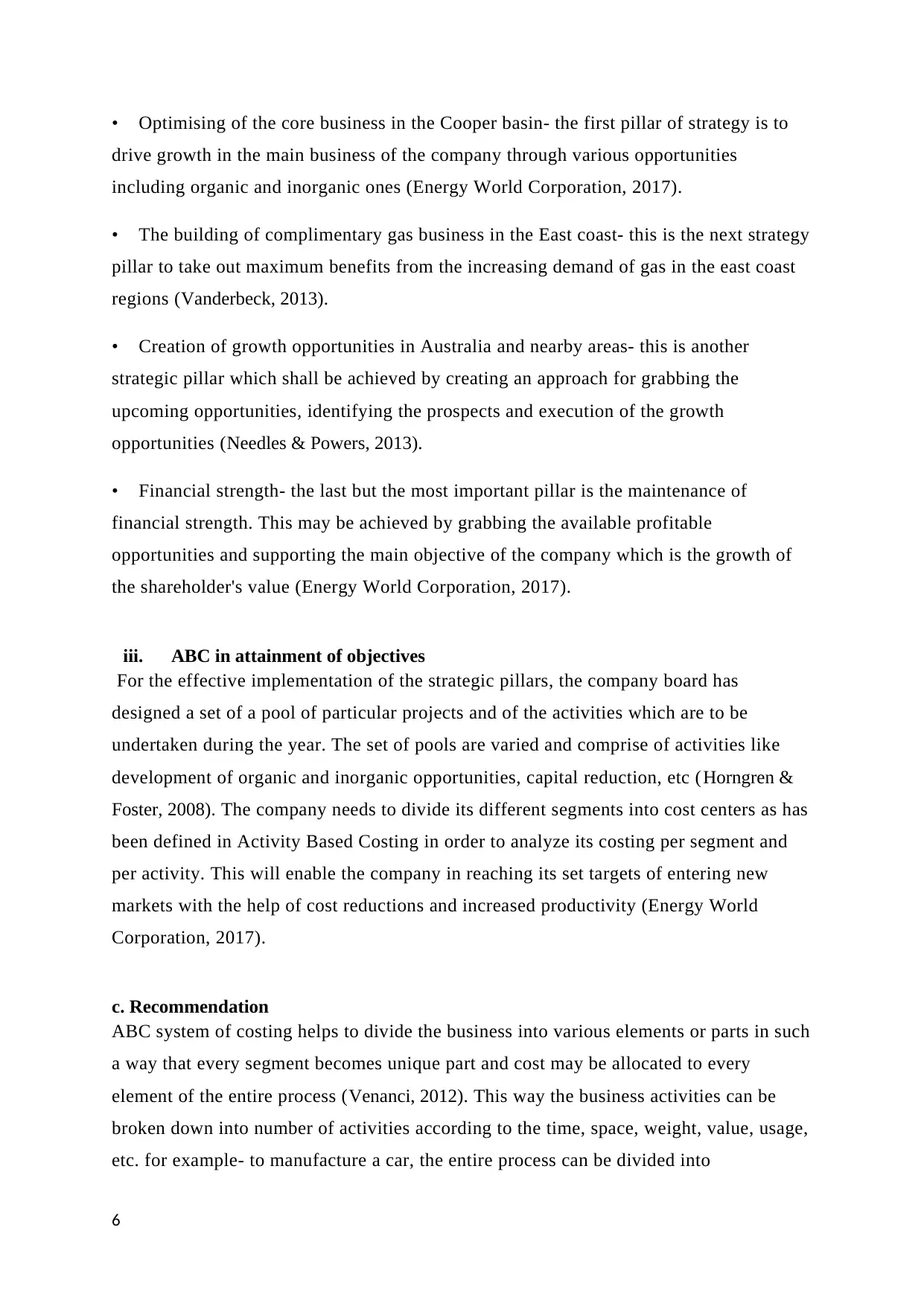
• Optimising of the core business in the Cooper basin- the first pillar of strategy is to
drive growth in the main business of the company through various opportunities
including organic and inorganic ones (Energy World Corporation, 2017).
• The building of complimentary gas business in the East coast- this is the next strategy
pillar to take out maximum benefits from the increasing demand of gas in the east coast
regions (Vanderbeck, 2013).
• Creation of growth opportunities in Australia and nearby areas- this is another
strategic pillar which shall be achieved by creating an approach for grabbing the
upcoming opportunities, identifying the prospects and execution of the growth
opportunities (Needles & Powers, 2013).
• Financial strength- the last but the most important pillar is the maintenance of
financial strength. This may be achieved by grabbing the available profitable
opportunities and supporting the main objective of the company which is the growth of
the shareholder's value (Energy World Corporation, 2017).
iii. ABC in attainment of objectives
For the effective implementation of the strategic pillars, the company board has
designed a set of a pool of particular projects and of the activities which are to be
undertaken during the year. The set of pools are varied and comprise of activities like
development of organic and inorganic opportunities, capital reduction, etc (Horngren &
Foster, 2008). The company needs to divide its different segments into cost centers as has
been defined in Activity Based Costing in order to analyze its costing per segment and
per activity. This will enable the company in reaching its set targets of entering new
markets with the help of cost reductions and increased productivity (Energy World
Corporation, 2017).
c. Recommendation
ABC system of costing helps to divide the business into various elements or parts in such
a way that every segment becomes unique part and cost may be allocated to every
element of the entire process (Venanci, 2012). This way the business activities can be
broken down into number of activities according to the time, space, weight, value, usage,
etc. for example- to manufacture a car, the entire process can be divided into
6
drive growth in the main business of the company through various opportunities
including organic and inorganic ones (Energy World Corporation, 2017).
• The building of complimentary gas business in the East coast- this is the next strategy
pillar to take out maximum benefits from the increasing demand of gas in the east coast
regions (Vanderbeck, 2013).
• Creation of growth opportunities in Australia and nearby areas- this is another
strategic pillar which shall be achieved by creating an approach for grabbing the
upcoming opportunities, identifying the prospects and execution of the growth
opportunities (Needles & Powers, 2013).
• Financial strength- the last but the most important pillar is the maintenance of
financial strength. This may be achieved by grabbing the available profitable
opportunities and supporting the main objective of the company which is the growth of
the shareholder's value (Energy World Corporation, 2017).
iii. ABC in attainment of objectives
For the effective implementation of the strategic pillars, the company board has
designed a set of a pool of particular projects and of the activities which are to be
undertaken during the year. The set of pools are varied and comprise of activities like
development of organic and inorganic opportunities, capital reduction, etc (Horngren &
Foster, 2008). The company needs to divide its different segments into cost centers as has
been defined in Activity Based Costing in order to analyze its costing per segment and
per activity. This will enable the company in reaching its set targets of entering new
markets with the help of cost reductions and increased productivity (Energy World
Corporation, 2017).
c. Recommendation
ABC system of costing helps to divide the business into various elements or parts in such
a way that every segment becomes unique part and cost may be allocated to every
element of the entire process (Venanci, 2012). This way the business activities can be
broken down into number of activities according to the time, space, weight, value, usage,
etc. for example- to manufacture a car, the entire process can be divided into
6
⊘ This is a preview!⊘
Do you want full access?
Subscribe today to unlock all pages.

Trusted by 1+ million students worldwide
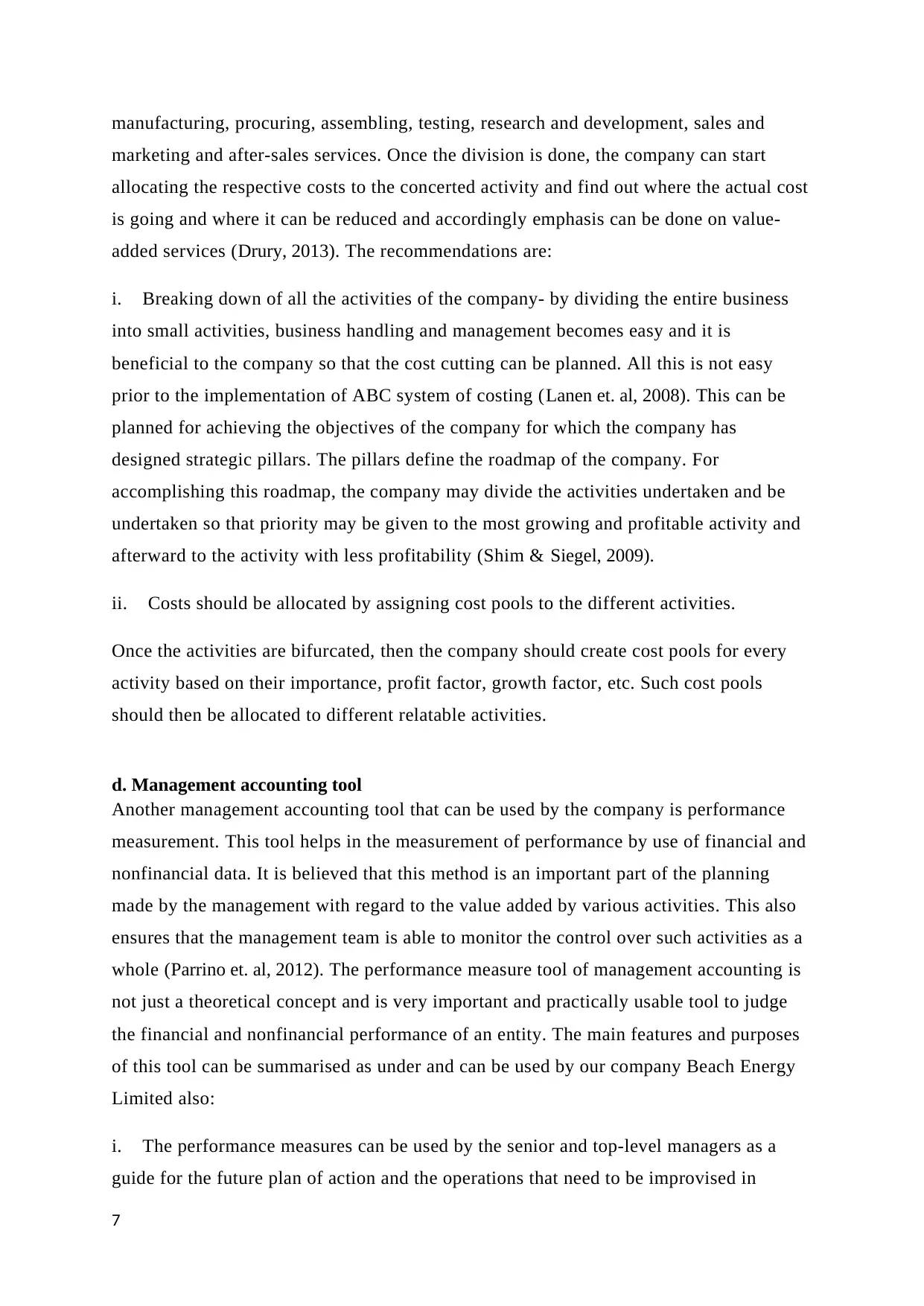
manufacturing, procuring, assembling, testing, research and development, sales and
marketing and after-sales services. Once the division is done, the company can start
allocating the respective costs to the concerted activity and find out where the actual cost
is going and where it can be reduced and accordingly emphasis can be done on value-
added services (Drury, 2013). The recommendations are:
i. Breaking down of all the activities of the company- by dividing the entire business
into small activities, business handling and management becomes easy and it is
beneficial to the company so that the cost cutting can be planned. All this is not easy
prior to the implementation of ABC system of costing (Lanen et. al, 2008). This can be
planned for achieving the objectives of the company for which the company has
designed strategic pillars. The pillars define the roadmap of the company. For
accomplishing this roadmap, the company may divide the activities undertaken and be
undertaken so that priority may be given to the most growing and profitable activity and
afterward to the activity with less profitability (Shim & Siegel, 2009).
ii. Costs should be allocated by assigning cost pools to the different activities.
Once the activities are bifurcated, then the company should create cost pools for every
activity based on their importance, profit factor, growth factor, etc. Such cost pools
should then be allocated to different relatable activities.
d. Management accounting tool
Another management accounting tool that can be used by the company is performance
measurement. This tool helps in the measurement of performance by use of financial and
nonfinancial data. It is believed that this method is an important part of the planning
made by the management with regard to the value added by various activities. This also
ensures that the management team is able to monitor the control over such activities as a
whole (Parrino et. al, 2012). The performance measure tool of management accounting is
not just a theoretical concept and is very important and practically usable tool to judge
the financial and nonfinancial performance of an entity. The main features and purposes
of this tool can be summarised as under and can be used by our company Beach Energy
Limited also:
i. The performance measures can be used by the senior and top-level managers as a
guide for the future plan of action and the operations that need to be improvised in
7
marketing and after-sales services. Once the division is done, the company can start
allocating the respective costs to the concerted activity and find out where the actual cost
is going and where it can be reduced and accordingly emphasis can be done on value-
added services (Drury, 2013). The recommendations are:
i. Breaking down of all the activities of the company- by dividing the entire business
into small activities, business handling and management becomes easy and it is
beneficial to the company so that the cost cutting can be planned. All this is not easy
prior to the implementation of ABC system of costing (Lanen et. al, 2008). This can be
planned for achieving the objectives of the company for which the company has
designed strategic pillars. The pillars define the roadmap of the company. For
accomplishing this roadmap, the company may divide the activities undertaken and be
undertaken so that priority may be given to the most growing and profitable activity and
afterward to the activity with less profitability (Shim & Siegel, 2009).
ii. Costs should be allocated by assigning cost pools to the different activities.
Once the activities are bifurcated, then the company should create cost pools for every
activity based on their importance, profit factor, growth factor, etc. Such cost pools
should then be allocated to different relatable activities.
d. Management accounting tool
Another management accounting tool that can be used by the company is performance
measurement. This tool helps in the measurement of performance by use of financial and
nonfinancial data. It is believed that this method is an important part of the planning
made by the management with regard to the value added by various activities. This also
ensures that the management team is able to monitor the control over such activities as a
whole (Parrino et. al, 2012). The performance measure tool of management accounting is
not just a theoretical concept and is very important and practically usable tool to judge
the financial and nonfinancial performance of an entity. The main features and purposes
of this tool can be summarised as under and can be used by our company Beach Energy
Limited also:
i. The performance measures can be used by the senior and top-level managers as a
guide for the future plan of action and the operations that need to be improvised in
7
Paraphrase This Document
Need a fresh take? Get an instant paraphrase of this document with our AI Paraphraser
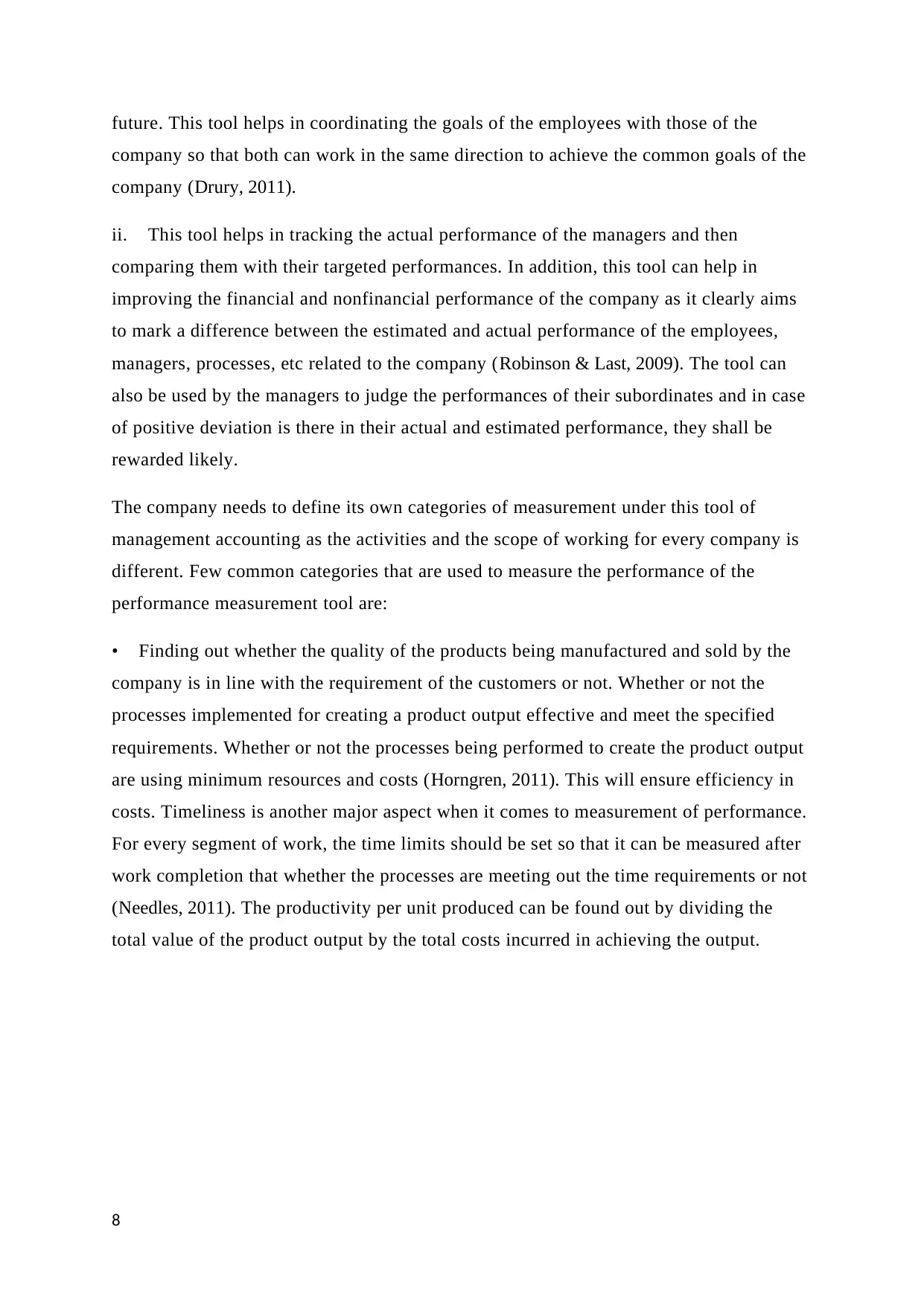
future. This tool helps in coordinating the goals of the employees with those of the
company so that both can work in the same direction to achieve the common goals of the
company (Drury, 2011).
ii. This tool helps in tracking the actual performance of the managers and then
comparing them with their targeted performances. In addition, this tool can help in
improving the financial and nonfinancial performance of the company as it clearly aims
to mark a difference between the estimated and actual performance of the employees,
managers, processes, etc related to the company (Robinson & Last, 2009). The tool can
also be used by the managers to judge the performances of their subordinates and in case
of positive deviation is there in their actual and estimated performance, they shall be
rewarded likely.
The company needs to define its own categories of measurement under this tool of
management accounting as the activities and the scope of working for every company is
different. Few common categories that are used to measure the performance of the
performance measurement tool are:
• Finding out whether the quality of the products being manufactured and sold by the
company is in line with the requirement of the customers or not. Whether or not the
processes implemented for creating a product output effective and meet the specified
requirements. Whether or not the processes being performed to create the product output
are using minimum resources and costs (Horngren, 2011). This will ensure efficiency in
costs. Timeliness is another major aspect when it comes to measurement of performance.
For every segment of work, the time limits should be set so that it can be measured after
work completion that whether the processes are meeting out the time requirements or not
(Needles, 2011). The productivity per unit produced can be found out by dividing the
total value of the product output by the total costs incurred in achieving the output.
8
company so that both can work in the same direction to achieve the common goals of the
company (Drury, 2011).
ii. This tool helps in tracking the actual performance of the managers and then
comparing them with their targeted performances. In addition, this tool can help in
improving the financial and nonfinancial performance of the company as it clearly aims
to mark a difference between the estimated and actual performance of the employees,
managers, processes, etc related to the company (Robinson & Last, 2009). The tool can
also be used by the managers to judge the performances of their subordinates and in case
of positive deviation is there in their actual and estimated performance, they shall be
rewarded likely.
The company needs to define its own categories of measurement under this tool of
management accounting as the activities and the scope of working for every company is
different. Few common categories that are used to measure the performance of the
performance measurement tool are:
• Finding out whether the quality of the products being manufactured and sold by the
company is in line with the requirement of the customers or not. Whether or not the
processes implemented for creating a product output effective and meet the specified
requirements. Whether or not the processes being performed to create the product output
are using minimum resources and costs (Horngren, 2011). This will ensure efficiency in
costs. Timeliness is another major aspect when it comes to measurement of performance.
For every segment of work, the time limits should be set so that it can be measured after
work completion that whether the processes are meeting out the time requirements or not
(Needles, 2011). The productivity per unit produced can be found out by dividing the
total value of the product output by the total costs incurred in achieving the output.
8
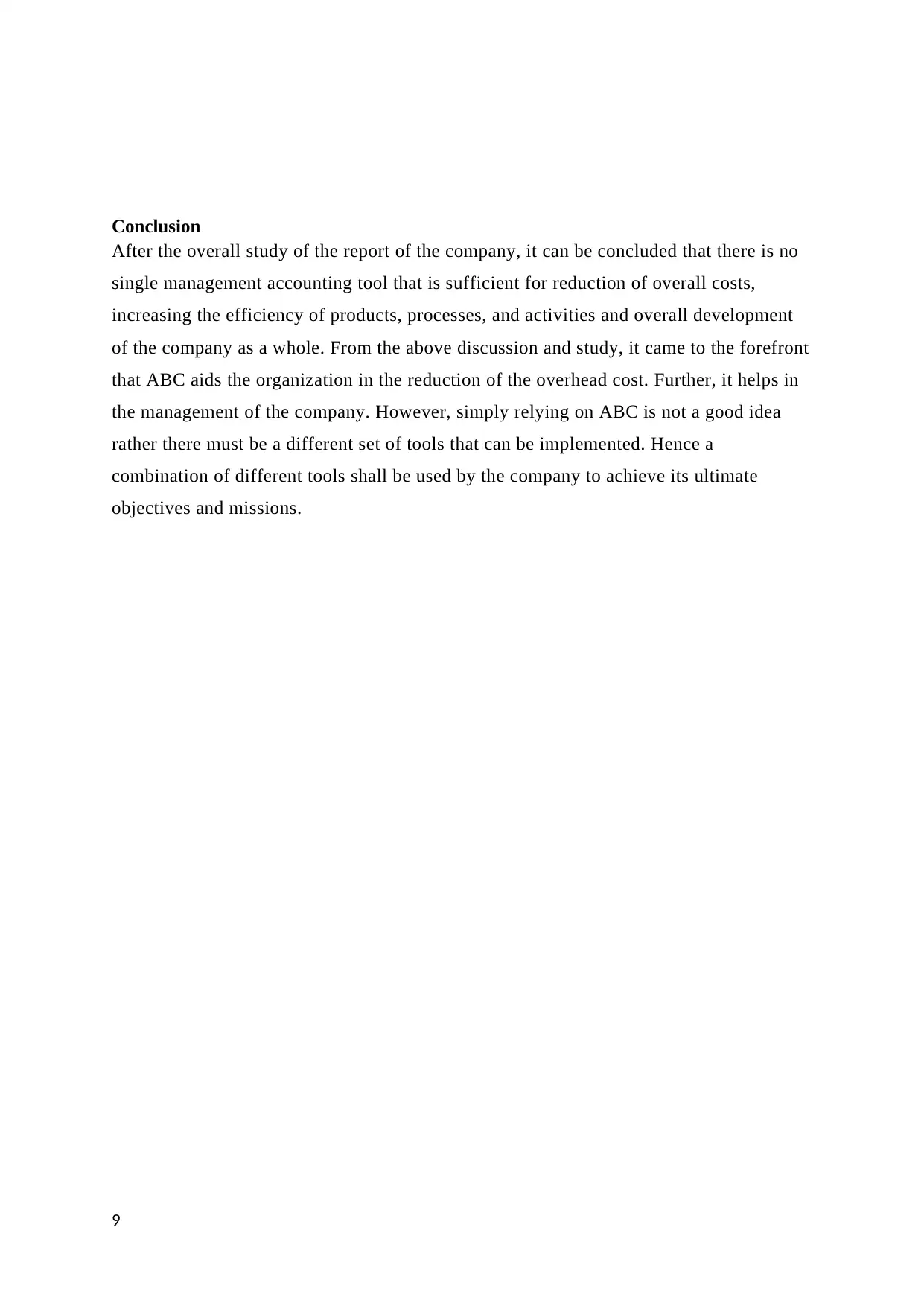
Conclusion
After the overall study of the report of the company, it can be concluded that there is no
single management accounting tool that is sufficient for reduction of overall costs,
increasing the efficiency of products, processes, and activities and overall development
of the company as a whole. From the above discussion and study, it came to the forefront
that ABC aids the organization in the reduction of the overhead cost. Further, it helps in
the management of the company. However, simply relying on ABC is not a good idea
rather there must be a different set of tools that can be implemented. Hence a
combination of different tools shall be used by the company to achieve its ultimate
objectives and missions.
9
After the overall study of the report of the company, it can be concluded that there is no
single management accounting tool that is sufficient for reduction of overall costs,
increasing the efficiency of products, processes, and activities and overall development
of the company as a whole. From the above discussion and study, it came to the forefront
that ABC aids the organization in the reduction of the overhead cost. Further, it helps in
the management of the company. However, simply relying on ABC is not a good idea
rather there must be a different set of tools that can be implemented. Hence a
combination of different tools shall be used by the company to achieve its ultimate
objectives and missions.
9
⊘ This is a preview!⊘
Do you want full access?
Subscribe today to unlock all pages.

Trusted by 1+ million students worldwide

References
Drury, C. (2011). Cost and management accounting. Andover, Hampshire, UK: South-
Western Cengage Learning.
Drury, C. M. (2013). Management and cost accounting. Springer.
Energy World Corporation. (2017). Energy World Corporation Annual report and
accounts 2017. Retrieved from:
https://www.asx.com.au/asx/share-price-research/company/EWC
Horngren, C T & Foster, G. (2008). Cost Accounting: A Managerial Emphasis. United
States Edition
Horngren, C. (2011). Cost accounting. Frenchs Forest, N.S.W.: Pearson Australia.
Lanen, W. N., Anderson, S & Maher, M. W. (2008). Fundamentals of cost accounting. NY:
Hang Loose press.
Larry M. W & Christopher J. S. (2012). Managerial and Cost Accounting. Pearson Press
Marsh, C. (2009). Mastering financial management. Harlow: Financial Times Prentice Hall
Needles, B. E.& Powers, M. (2013). Principles of Financial Accounting. New York Press
Needles, S. C. (2011). Managerial Accounting, USA: South-Western Cengage Learning .
Parrino, R, Kidwell, D. & Bates, T. (2012). Fundamentals of corporate finance. Hoboken,
Robinson, M., & Last, D. (2009). Budgetary Control Model: The Process of Translation.
Accounting, Organization, and Society. NY Press
Shim, J. K & Siegel, J G. (2009). Modern Cost Management and Analysis. Barron's
Education Series
Vaitilingam, R. (2010). The Financial Times Guide to Using the Financial Pages. London:
FT Prentice Hall.
Vanderbeck, E J. (2013). Principles of Cost Accounting. Oxford university press
Venanci, D. (2012). Financial Performance Measures and Value Creation. State of art .
New York: Springer.
10
Drury, C. (2011). Cost and management accounting. Andover, Hampshire, UK: South-
Western Cengage Learning.
Drury, C. M. (2013). Management and cost accounting. Springer.
Energy World Corporation. (2017). Energy World Corporation Annual report and
accounts 2017. Retrieved from:
https://www.asx.com.au/asx/share-price-research/company/EWC
Horngren, C T & Foster, G. (2008). Cost Accounting: A Managerial Emphasis. United
States Edition
Horngren, C. (2011). Cost accounting. Frenchs Forest, N.S.W.: Pearson Australia.
Lanen, W. N., Anderson, S & Maher, M. W. (2008). Fundamentals of cost accounting. NY:
Hang Loose press.
Larry M. W & Christopher J. S. (2012). Managerial and Cost Accounting. Pearson Press
Marsh, C. (2009). Mastering financial management. Harlow: Financial Times Prentice Hall
Needles, B. E.& Powers, M. (2013). Principles of Financial Accounting. New York Press
Needles, S. C. (2011). Managerial Accounting, USA: South-Western Cengage Learning .
Parrino, R, Kidwell, D. & Bates, T. (2012). Fundamentals of corporate finance. Hoboken,
Robinson, M., & Last, D. (2009). Budgetary Control Model: The Process of Translation.
Accounting, Organization, and Society. NY Press
Shim, J. K & Siegel, J G. (2009). Modern Cost Management and Analysis. Barron's
Education Series
Vaitilingam, R. (2010). The Financial Times Guide to Using the Financial Pages. London:
FT Prentice Hall.
Vanderbeck, E J. (2013). Principles of Cost Accounting. Oxford university press
Venanci, D. (2012). Financial Performance Measures and Value Creation. State of art .
New York: Springer.
10
1 out of 10
Related Documents
Your All-in-One AI-Powered Toolkit for Academic Success.
+13062052269
info@desklib.com
Available 24*7 on WhatsApp / Email
![[object Object]](/_next/static/media/star-bottom.7253800d.svg)
Unlock your academic potential
Copyright © 2020–2025 A2Z Services. All Rights Reserved. Developed and managed by ZUCOL.




